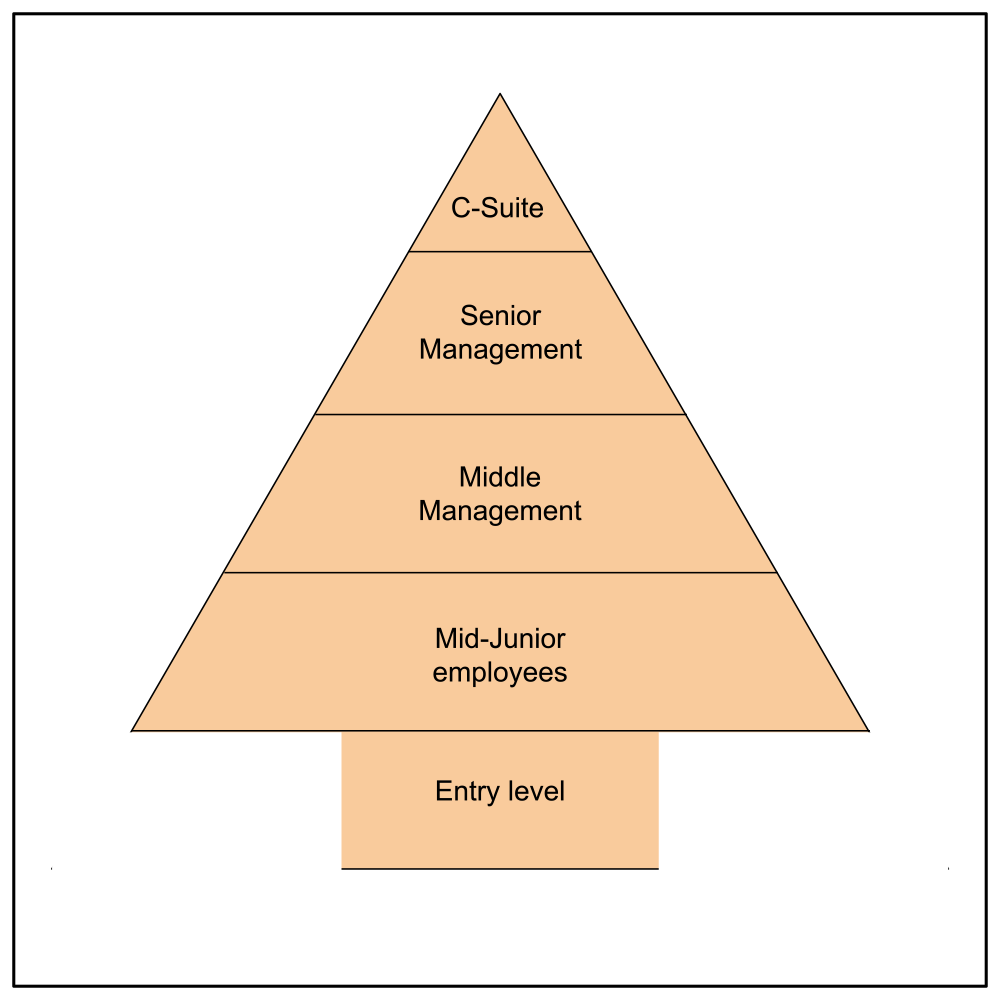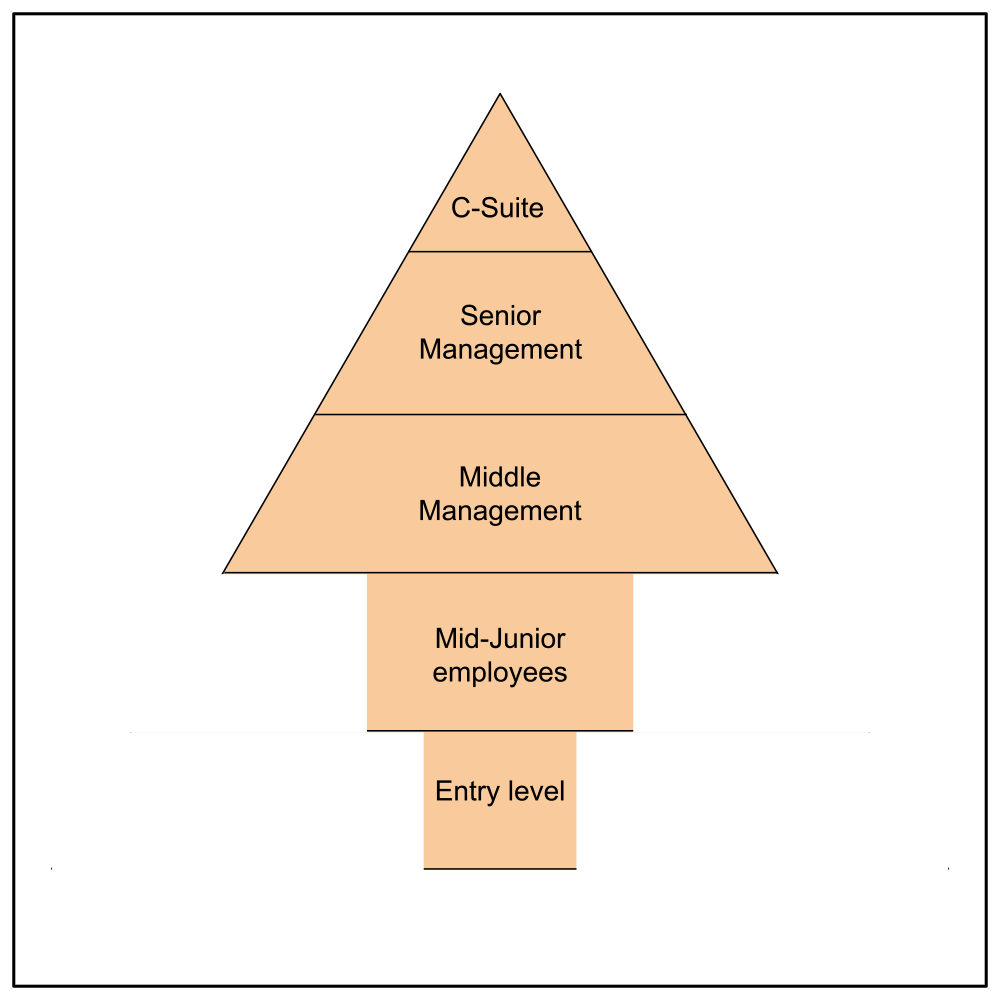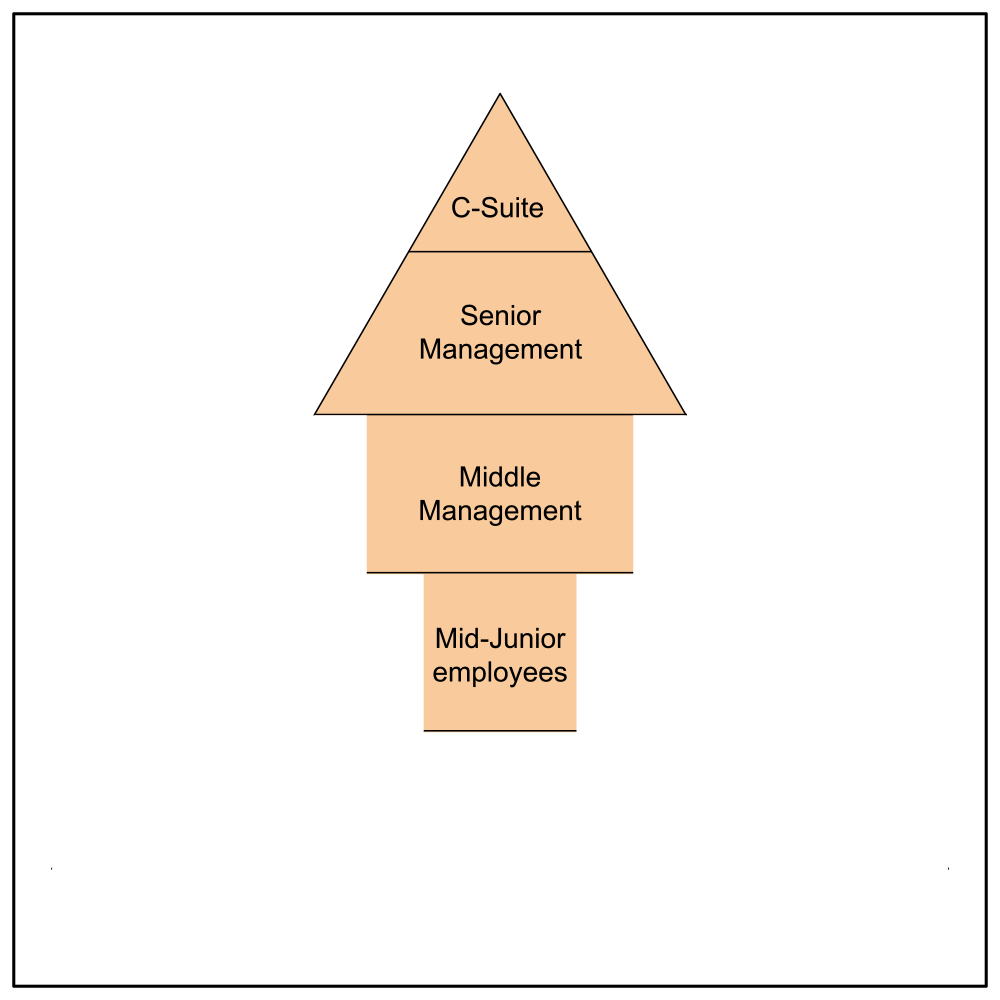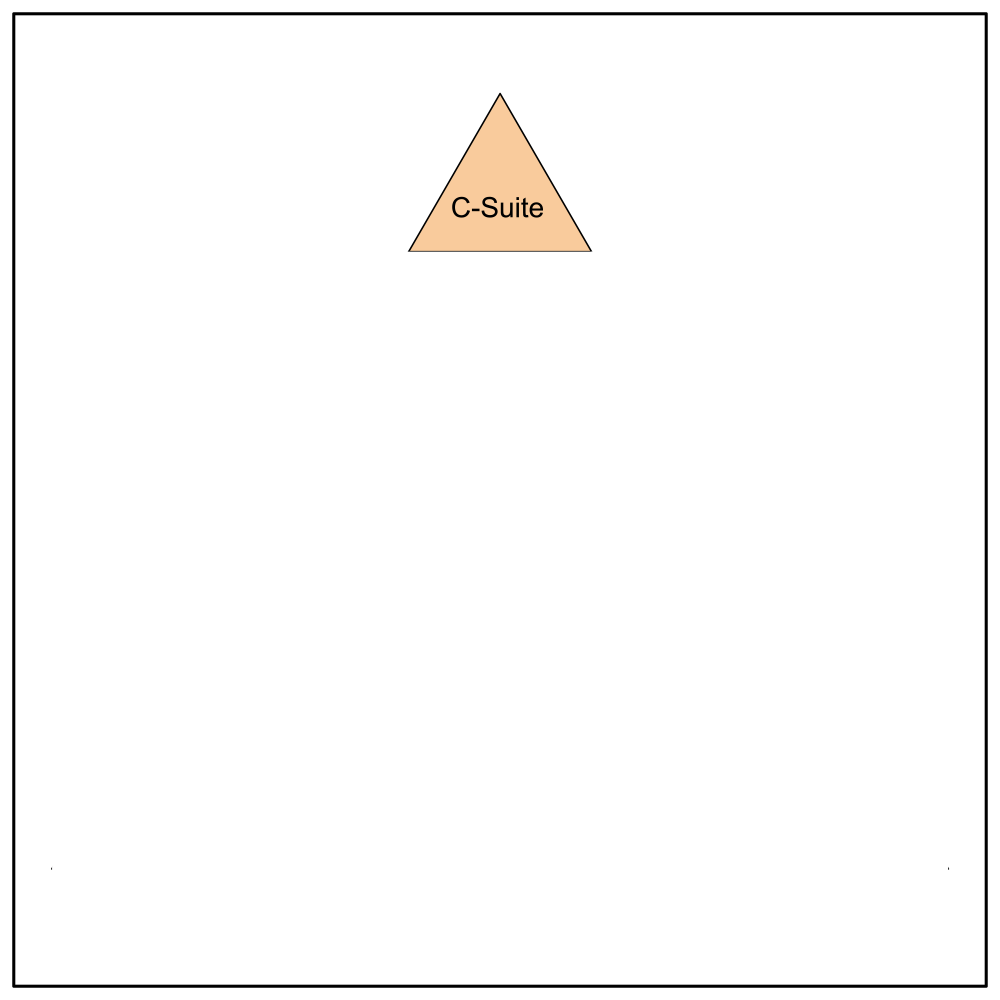This essay is out of date. To view the full essay series, visit intelligence-curse.ai.
“Yes, the pyramids have been built, but if you give me 300,000 disciplined men and give me 30 years, I could build a bigger one.” — Werner Herzog
OpenAI’s goal is to build AGI (and then go further), which they define as “a highly autonomous system that outperforms humans at most economically valuable work”. The other AI labs – Meta, DeepSeek, et. al. – have said the same. Many of them have released very early AI agents, or systems that can perform tasks on the internet for you. The CEOs of these companies think they might achieve it in just a few years, some saying as early as 2026. So it’s worth asking: when AGI shows up at your workplace, what will happen to your job?
The junior employees at large firms will lose first, through a combination of hiring slowdowns and some firings. As agents get better and better, AI will climb the corporate pyramid and replace workers one by one. Eventually, in many industries, there will be competitive pressures that force companies to stop hiring (and start firing) throughout the organization.
I call this pyramid replacement. How does it work?
Let’s focus on white collar companies
White collar work (defined as typical office work) in medium-to-large firms is uniquely exposed to AI automation, especially relative to other work. Robotics looks farther away than AGI, and the companies with physically-automatable work hire and fire differently than large white collar firms. Small businesses hire with less clear structures, with fewer easily-automatable employees and less clearly defined work. Government employees are also (supposed to be) hard to fire.
So let’s talk about larger white collar employers, since I expect they’ll be the first to get hit with the intelligence curse. I’ll define this as firms that employ more than 500 people (though that number is somewhat arbitrary) and whose employees perform typical office work. Really, it’s firms whose personnel distribution looks something like this:
Assume a slow to medium takeoff
In this model, our first AGI system is slow and a bit expensive. It can do the work of one employee, but it works at about the same speed. Because it doesn’t take breaks, it can produce more work in 24 hours, but it is not a 10x improvement. It’ll also need steering — it won’t manage itself. Occasionally, it makes mistakes that require human correction.
This system will get better over time, but it is not superintelligent the day after it releases. Automated AI research takes times, and the AI companies set aside lots of their compute to earn money in the economy.
How talent flows in organizations today
Entry-level employees don’t stay entry-level forever. Many of them become ready for a promotion, which means they can do more valuable work for the company. Some of them don’t see opportunities for growth or find another job and leave. At the same time, many of the middle to senior employees leave, retire, or otherwise stop working for the company.
All of this creates room for talent to flow upwards, but it requires the firm to regularly replenish the organization’s bottom layer.
So every year, companies hire fresh talent from the best universities they can recruit from. They hold career fairs, take on interns, and spend lots of time training these smart but low-context individuals. Then, they give them busywork – the firm’s simplest, least-fun tasks. It’s thankless, but it teaches them how the company works so they can later manage future grunt workers entry level employees as they move up the pyramid.
Why fire when you can choose not to hire?
When the first wave of capable AI agents arrive – in this case agents that can produce entry-level work outputs at half or less of the cost of a human employee with moderate steering – companies have an easy lever to pull to boost productivity and save money on wages. Rather than firing anyone, they can just hire less analysts.
Let’s say it looks like a system I described in an earlier piece:
“Fast forward to 2030. BigLab just released an AI agent powered by GPT-8. It completes any task 20% faster and 10% better than any of your analysts. Oh, and running it to do the work of one analyst costs $10,000 per year – that’s at least an 80% cost reduction. It might let your best analyst do the job of 10, or you could use it to clone the best one and automate the analyst class entirely.”
How might companies respond to this new tool? They have a few options:
Do nothing
Fire everyone
Adopt it slowly
Some firms might do nothing. I expect they’ll regret it quickly – one of their competitors will adopt it, and their productivity gains will help them earn significant leads. Competitive pressures will be a strong force towards adoption. Most firms won’t fire everyone the day such a tool is released, and the few that do will suffer. This system might be slightly better and a lot cheaper, but there will still be some glitches to iron out.
That leaves everyone else: the slow adopters. I suspect most firms will spend some time rolling out this tool. Once they see that it increases their best junior employees’ work by 2, 5, or 10x, they’ll start to wonder why they hire so many entry-level analysts. Thanks to their drop-in agents, they can get more work done with fewer employees.
I think the first wave of virtual co-workers, likely a combination of LLM scaffolds from startups and natively agentic but slow models from the labs, will allow companies to shrink their organizations without firing anyone. It should look like this:
You shouldn’t expect it to stop there, as AI progress continues. The last agents weren’t good enough to replace anyone but the entry-level employees, and they needed regular steering. But some time has passed, and the labs have released new systems. These are natively agentic, more directable, and can work without intervention for even longer. These systems just work with your existing tech stack. At this point, a firm will need very few entry-level employees and junior managers. Plus, they have fewer employees to promote.
As people get promotions, the org chart will shift again:
In normal times, one reason companies hire entry-level employees is to spot, train, and promote their future middle and senior managers. If no one is at the bottom of the pyramid, there’s no one to move to the top. But if they’re somewhat observant, they’ll realize that as this AI thing gets even better, they won’t need many human employees at any level for much longer.
Eventually, the employees start to hold the firms back
At this point, the C-Suite has a dilemma. Their entry-level hires are expensive and not that useful on day one – they’re only valuable in a time where every org is staffed by humans at every level. Moreover, another system has been released. This time, the new agents do the work better when the entry-level employees don’t interrupt them. If this progress continues, most managers will be managing agents, and increasingly senior work will become automatable.
They have an expensive problem on their hands. They don’t want to fire a bunch of people, mostly for optics, but they really should do something to boost efficiency and cut costs.
For some firms, it’ll take a shock – a recession, a downturn, or a bad quarterly earnings report, to announce layoffs as a cost-cutting measure. In the most competitive sectors, action might happen faster. Either way, the org chart will quickly look like this:
Then, the agents (once again) get better. Now they can do all of the task-based work in the company. The market is expecting the next termination wave. While public resentment is growing, the shareholders demand the productivity benefits to increase earnings. Plus, all the other firms are doing it. If the firm doesn’t automate most of their work, they’ll lose to their competitors. The pattern repeats, but this time it’s even harsher:
Some time passes, and once again new agents get released. This time, they can do all intellectual labor in the company, and they do it better without senior management in the loop. On top of that, the older AI systems now cost a few hundred dollars for a comparable year of entry-level human labor.
Many firms make the call: they only need the c-suite.
White collar industries become a collection of a few people sitting on top of pyramids made of code.
A blank org chart
Some time passes, and the agents get even better. Now, they can track every interaction the company has, both internally and externally. A swarm of them can execute every decision, and the best of them can make strategic decisions exceptionally fast.
The board of some firms realize that the C-Suite is now less capable of managing the company than the best agents. CEOs are forgetful, and they don’t have panopticon-level insight into everything their company is doing – but their best agents do.
This time, the board makes the call: they can build an even bigger pyramid if every single person is automated — CEOs included. For some firms, the best performing org chart look like this1:
Some caveats are needed
Obviously, this is a very simplified model. Let’s add some nuance.
First, I assume AI progress continues, that AGI is possible, and that it is coming soon. Even so, this argument does not rest on superintelligence, an intelligence explosion, or other possibilities that might feel sci-fi to you but don’t to the people actually building the technology. This means I assume that the vast majority of office tasks are automatable via software.
It's not obvious how fast this will happen, which is why I don’t say “two years later”. Instead, I contend that you climb the pyramid as the models get better and diffusion overcomes barriers to adoption. “Better” is measured by when they can reliably do most of the work in a seniority layer of a company.
Speaking of diffusion, barriers – things like regulatory barriers, investor/leadership skepticism, a lack of automation pressures from competing companies, high costs or use limitations, labor or union pressures, or a lack of economic downturns – could all slow this process down.
You may see a more jagged effect than this model demonstrates. Some jobs (ex: software engineers) are more immediately automatable than others (ex: mid-to-bottom of the funnel enterprise sales), even at different levels of seniority. You could model this as a pyramid for each corporate function. Those have pyramids within a large organization, and will likely follow a similar pattern.
Some white collar industries will be much more resistant to this than others. Tech companies could be largely automable with one or two more leaps in AI performance. Other white collar industries might rely on prestige, signalling, or soft skills that will be harder to automate. This probably doesn’t matter at the entry level, but it matters for senior employees who do lots of important, interpersonal work.
Finally, this is a default trajectory for large companies. Tech or governance interventions could dramatically change this pattern.2
The future of work?
To put it bluntly, traditional white collar work, the economic engine of developed economies, is unlikely to survive the AI revolution. This isn’t a 2050 or 2100 problem – it is a problem for today’s entrepreneurs, policymakers, and institutions.
The popular thing is to claim that new, better jobs will be created, and that wages will rise as a result. Shouts of “comparative advantage” can be heard from many soon-to-be-displaced economists. But when economists actually take AI seriously, they seem to reach different conclusions. Modeling by Korinek and Suh demonstrates that by default, wages plummet:
So let’s expand the social safety net? UBI for everyone! One problem: we may not have the funds. A household making roughly $80,000 per year that sees both workers permanently displaced is not going to be thrilled with a fractional, permanent replacement wage. Moreover, expanding the social safety net will be limited by other fiscal constraints. Social security, funded by payroll taxes, is expected to be exhausted in 2033. This would create significant pressure to shrink social safety nets at a time where (if innovation and diffusion and fast enough) voters may be demanding massive expansions.
The effects of this won’t be isolated to white collar work. Displaced workers may join blue-collar professions (at least until the robots show up). On top of that, some blue collar work is on track to get displaced. Investment in self-driving vehicles for transportation and specialized robotics for manufacturing make those sectors ripe for displacement as well. With all of this increased competition, wages may spiral downward for blue collar workers as well.
This all means that, once AGI is on the scene, a whole lot of people will be making a lot less money, if they’re earning at all. Once the robots finally show up, everyone might be out of a job. It’s extremely difficult to overstate the magnitude of change this will bring about.
And remember, this is a slow model. If on day one, AGI can reliably do the work of every employee in the company, this could go a lot faster.
We shouldn’t aim for a world where anyone is worse off because we created transformative technology. But unless people start building for regular human control and use, and unless policymakers start commissioning the studies to examine this problem in depth, that is exactly where we are headed.
Thank you to Duncan McClements, Rudolf Laine, Deric Cheng, Luca Gandrud, Bilal Chughtai, and Sam Cherry for reviewing drafts of this post.
I am at my most speculative here. For a very long time (and maybe forever), legal barriers to agent-owned companies should prevent this. But it seems entirely plausible that some white collar firms would perform better if they were run by agents more capable than humans. Oftentimes, if it would be better, the market finds a way.
I promise I’m still working on the “solutions to the intelligence curse” piece. I expect to publish it in the next few weeks. In the meantime, if you have thoughts on the “what can we build” front – especially if you have expertise in biosecurity, open-weights models, humanoid robotics, or cutting edge alignment research – please get in contact with me. DMs open.













> we simply do not have enough money for UBI
I’m confused by this part - in a world where white collar productivity doubles (the agent runs at half the cost), why wouldn’t we have enough money?
Many people will lose their jobs and will not be able to pay for their disproportionately large apartments with a pool and air conditioning, possibly becoming homeless. If companies around the world start laying off people, this will significantly reduce consumption, and the question is where the economic growth will come from if consumption is decreasing. Reducing consumption will lead to the government collecting less taxes. So it is not clear where the government will get money for UBI and shitty jobs. Most people will become homeless so I would not be sure that construction workers, plumbers, electricians, and other blue-collar jobs will be safe. If people do not have money, they will not be able to go to the doctor and will die from a simple disease, and also will not buy a car, computers, smartphones, etc. One thing I can say for sure is that I do not see political and economic means to solve this crisis.